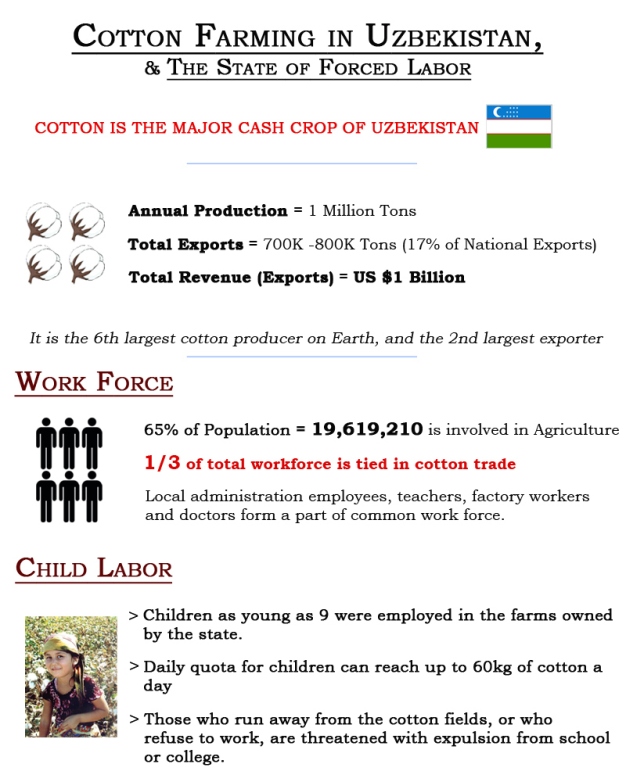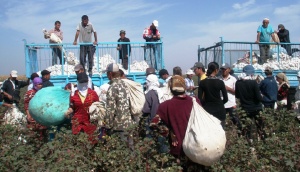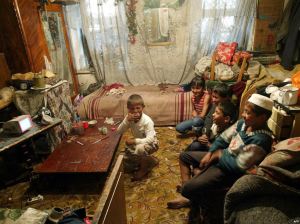Almost one million Uzbek fought alongside Russians against the Nazi force in WW II. After 41 years, with the dissolution of the Soviet Union, Uzbekistan declared independence on August 31, 1991.
Under the autocratic leadership of Islam Karimov, the nation fell into a dictatorial regime where choice of life was a mere right possessed only by the powerful and rich.
Cotton Plantation & Slavery
The cotton plantation is synonymous to the darker past of modern history. Primarily, referring to the Slavery of America, cotton plantation began in larger scale in 1621 in southern states of USA by applying human slaves; African, Mexican and Caribbean, in form of forced labor.
By the late 1920s, around two-thirds of all African-American tenants and almost three-fourths of the croppers worked on cotton farms. It took a long time even after the assassination of Lincoln to completely abolish the slavery, moreover, forced labor to disappear entirely.
In Uzbekistan, the cotton (known as White Gold) farming peaked during the regime of Soviet Union. People, of every class, caste and age, were forced into the cotton fields. Even today, the Uzbek government owns the farms and forces its people to work in the field in return of a meager pay, and those who speak against the atrocity are penalized hefty compensations of various sorts.
Other neighboring nations in Central Asia follow suit. They have been forcibly employing people into cotton farming. It proved to be a form of oppression, time after time.
State of Forced Labor in Uzbekistan
The current state of Uzbek people working in the field isn’t different from that of African Americans living in America 100-200 years ago. Though, not brutally harassed by the owners or whipped most of the times for not meeting the daily quota, workers in Uzbekistan still fear for their lives. People from every walk of life are compelled to sign a voluntary form against their will to work in a cotton field during the great harvest season.
Government employees who wish to resist the enforced labor are required to pay $200 as a form of compensation. Those who plead international organizations and human rights groups to interfere in the matter are humiliated and exiled from the nation altogether.
Info-graphic on Uzbekistan’s Cotton Farming

65% of the total population, which accounts for 19,619,210 people, are mobilized every year for the very purpose of harvesting cotton. Even people far related to agriculture are pulled in. Threats of expulsion, loss of employment or pension etc are common methods of torture implied by the government to force the labor meet its yearly quota of cotton exports, which alone stands to be US $1 Billion.
Denial of basic rights, human rights, demand for equal and fair pay and choice of employment doesn’t exist in this part of Central Asia. With Islam Karimov on power, the atrocity seems to continue till infinity.
Child Labor & Denial of Human Rights
Children are the usual form of labor used during harvest of cotton. Kids, as young as 9, were used as intensive labor by the state during cotton harvesting. As early as 2011, Uzbek state dropped using kids in the field, however, the trend still continues (including many other Central Asian nations) despite the protest of Human rights group and others against Karimov’s dictatorship.
Kids aging 13 or more are brought onto the field and are forced to work 12 hours a day with the daily quota of 60 kg, and they are crammed inside a house with poor living conditions.
These are menials which are denied proper wages or bonuses, as the profit from exports is ripped by the government entirely.
Last year’s cotton harvest in Uzbekistan saw again hundreds of thousands of children and adults forced to pick cotton during the harvest.
Although under pressure from campaigners the government avoided the mass mobilization of younger children, it forcibly mobilized older children from secondary schools (15 to 18-year-old) and adults.
~AntiSlavery.org
~Gallery~
Resources
Slavery in Uzbek cotton industry @AntiSlavery.org, Forced labor in cotton sector @CottonCampaign.org, The life of Uzbek cotton farmers @Rferl.org









